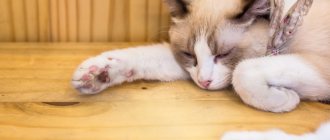Cat fleas.
They are not dangerous to humans, but they can bite him - red itchy blisters appear on the body. Bars drops are effective in the fight against fleas . They are applied to the withers so that the animal cannot lick them off. Drops are absorbed through the skin into the animal's blood. The concentration is not dangerous for the cat, but is destructive for fleas. When bitten, poisoning occurs through the blood. After 3-4 days, the pet needs to be bathed. When fighting fleas, be sure to give your cat an anthelmintic, because... fleas carry worm eggs on themselves.
When carrying out anti-flea measures, thoroughly clean the apartment, because... Nits and fleas may remain. Fry the cat's bedding and house in the sun.
General rules for the treatment of skin diseases
Cats have sensitive skin, which makes them susceptible to epidermal diseases more than other animals. The situation is complicated by the fact that many of them like to walk on their own, so their social circle cannot be limited in any way.
A sick cat requires careful care. Parasitic infections are contagious and take quite a long time to treat, so the cat needs to be isolated from other animals and people. When communicating with her, you must be careful, but do not make her an outcast in the family. This is especially true for kittens, because they really need the affection and attention of their owner.
It is very important to carefully follow all doctor’s orders and bring the animal to the clinic at certain intervals to monitor the dynamics of the disease.
Modern veterinary medicine has a rich range of medicines that can cope with almost any skin infection. If you do not miss the disease at the initial stage of its development, then it will not be difficult to cure it.
Otodectosis.
Disease of the skin of the auricle. Not transferable to humans. A microscopic mite settles in the ear, which can be easily diagnosed by the presence of almost black dirt in the cat’s ears. copes with ear mites . Twice treatment with drops with a break of a week will rid your pet's ears of mites. If it is not removed, inflammation (otitis media) develops in the ear canal, scratching and wounds become suppurated. When treating your cat's ears, follow the rules of personal hygiene. Although otodectosis is not dangerous for humans, it is not a bad idea to treat your hands with an antiseptic.
Ringworms of various etymologies are common skin diseases in cats.
For details on the types of lichen, their treatment, symptoms and photos of cats with lichen, see the article Lichen in cats: photos, signs and treatment. Ringworm is contagious and dangerous to humans . The causative agent is a fungus that grows rapidly throughout the body of the cat and requires immediate treatment. Treatment is carried out with medications.
Folk remedies (for example, oak bark) have a place in the treatment of this skin disease, but recovery occurs much later than with veterinary drugs.
Skin diseases of other etiologies
Skin diseases in domestic cats may be a consequence of loss of psychological balance, hormonal imbalance or some other imbalance in the body.
Psychogenic alopecia
The diagnosis of “psychogenic alopecia” is made to an animal when there is rapid hair loss. This condition is caused by prolonged stress or neurosis, which can occur:
- when changing place of residence or owner;
- when another cat or a new family member appears;
- after being alone for a long time.
First of all, the groin area, stomach, sides, and center line of the back lose hair. The exposed skin shows no signs of inflammation. Sedatives and antidepressants help relieve this condition:
- "Cat Baiyun";
- "Stop stress";
- "Amitriptyline."
More emotional breeds of cats are susceptible to the disease - Siamese, Abyssinian, Himalayan.
Cushing's syndrome
Hormonal imbalance in the body can provoke a very rare disorder - Cushing's syndrome. It is caused by excessive production of the animal hormone cortisone by the adrenal glands. Its main symptoms are:
- hair loss;
- behavioral changes (sudden aggression);
- increasing weakness;
- increased appetite and thirst.
The disease can be provoked by uncontrolled use of hormonal drugs. Conservative and surgical methods are used for treatment:
- the drug "Trilostane", which suppresses the production of hydrocortisone;
- if the symptoms are caused by a pituitary tumor, it is removed surgically.
Severe disease may require surgical removal of the adrenal glands, in which case the animal will be required to undergo hormone replacement therapy throughout its life.
Miliary dermatitis.
It manifests itself as dry ulcers and severe itching. The wounds bleed from scratching. The causes of miliary dermatitis are:
- allergies
- food dermatitis
- flea and tick bites.
to treat with an anthelmintic drug and against fleas. Why is it important to drive away worms - because they poison the body with waste products, and the liver is susceptible to irritants and allergens, causing inflammation in the skin.
Try to eliminate foods one by one that could theoretically cause an allergy. Change the tray filler.
Allergies in a cat can be caused by the owner's perfume.
The most common pathologies
Most often, the skin of cats is affected by fungal infections or parasites. Sometimes the cause is the body's intolerance to certain substances. Most often, cat owners encounter the following pathologies:
- Ringworm is a disease spread by fungi. The pathology is transmitted to humans. Does not affect dogs and birds. In the early stages, it is not difficult to cure an animal; in advanced cases, a methodical approach and a long course of therapy are required. With this disease, hair falls out, bald patches, red spots and pustules appear. The hair-free area of the skin is very dry and often flakes. Ringworm can manifest itself in different ways, but the symptoms always remain the same.
- Miliary dermatitis can be caused by poor diet, bacteria, or parasites. It also causes symptoms: baldness, itching, redness, and the formation of crusts on the skin, the top of which peels off. The animal’s immunity drops, its health worsens, and its mood deteriorates. Constant walking of the cat and an incorrectly chosen diet leads to the development of pathology. The provocateurs are often blood-sucking insects - fleas or ticks.
- One of the types of dermatitis is allergy. The most common types are household and food grade. In case of an allergic reaction, pale gums, rash, itching, ulcers, wounds, and pigmentation are observed. Sometimes the pathology is accompanied by vomiting and general weakness. An allergy can occur to everything, from the owner’s perfume to house dust. Free walking increases the likelihood of disease manifestations, since there are more potential allergens on the street than in the house.
- Bedsores are a dying area of skin. It loses sensitivity, begins to die and turns black. It is more common in cats that have suffered a serious illness or injury. During this period, their activity is limited, the animal lies on one side. Sometimes occurs in old animals.
- Eczema is the most unpredictable disease. It can be caused by skin contaminated with parasites, bacteria and fungi. Eczema often forms due to constant or incorrect wearing of a collar, or from the use of overalls made of artificial fabric. Sometimes the cause is other cat diseases that lead to an inflammatory process on the skin. For example, pathologies of the stomach, nervous system, kidneys or liver can be provocateurs. Eczema is ready to form on any part of the body, including the face.
- Scabies is characterized by redness, itching and peeling. Scabies is caused by microscopic mites that destroy the epithelium. These parasites are present on the body of any cat, but not in every case they cause scabies. The disease progresses with a lack of vitamins and decreased immunity. Scabies can be transmitted to other animals and humans.
- Demodectic mange is caused by tick bites. With this disease, dense tubercles, baldness, redness and the appearance of crusts form on the skin. The pathology affects large areas of the skin and spreads very quickly. Often the owner does not have time to take action and the animal dies.
- Acne is a consequence of improper animal care. With this disease, black spots form on the skin and bald patches appear. It begins to itch and crust over. Often trouble occurs when the animal is stressed or emotionally upset. If acne is not treated, inflammation begins, wounds and ulcers appear.
The best prevention of these diseases is to follow the rules of animal care. Try to contact a veterinarian at the first symptoms of pathologies. Many of these diseases are transmitted to humans.
Cat dandruff.
Dandruff can appear on the back, tail, and head of a pet. There are several reasons. The main ones: allergies to food, too dry air at home, reaction to the sun, the presence of parasites, vitamin deficiency (lack of vitamins A and B). First of all, eliminate potential allergens, purchase food for a healthy coat and for some time include foods rich in vitamins A and B in your cat’s diet - meat, fish oil, eggs. Learn proper nutrition for cats.
Daily brushing has a beneficial effect - a kind of massage that supplies the hair follicles with oxygen.
Also try bathing your cat with a veterinary shampoo with an antifungal effect - SynergyLabs Veterinary Formula with ketoconazole . The product is applied twice a week for 10 minutes, then washed off. What's good? The shampoo contains a powerful antifungal component. Excipients - aloe and lanolin soothe the skin, nourish it and protect it from bacteria. If the cause of dandruff is a fungus, shampoo will eliminate the problem.
Ringworm
Treatment
Problems in the functioning of the endocrine glands, pancreas, liver and stomach can provoke the formation of bald spots in different parts of the animal’s body. The existence of the disease will be confirmed by symptoms such as scabies, rash, dyspepsia, vomiting, nausea and fever.
We suggest you read: Flea shampoo for cats, composition and which one to choose
Excessively frequent brushing or bathing with shampoo also negatively affects the quality of cat hair. A bald spot on a cat’s back can also appear due to a sudden change in hygiene product.
Demodecosis.
The most dangerous skin disease in cats. The causative agent is a skin mite. When bitten, a swollen red spot forms, hair falls out on the face, bloody spots and pimples appear - pressing on which will provoke the outflow of white liquid with a large number of microscopic larvae. Sulfur ointment , veterinary drugs Stronghold and Advocad cope with demodicosis . You can also use human shampoo from the StopDemodex .
For prevention, provide your pet with a balanced, fortified diet.
How to diagnose what ails your cat
When it comes to identifying a skin disease, do not try to make a diagnosis yourself. Only a veterinarian and scraping analysis will help here. Considering that the causative agents of the diseases are different, the treatment is also different. To achieve your pet’s recovery as quickly as possible, contact a specialist; do not experiment on your own.
For prevention, keep the cat's bowls, tray, bedding, and house clean. Feed regularly with balanced food, comb the coat and inspect for parasites or wounds. Having learned what skin diseases look like in the photo and the treatment of ailments, carry out immediate therapy. A skin disease can be treated quickly if its cause is not a mite or fungus.
Let your pets be healthy and their fur shiny and silky.
Endoparasites
If you notice your pet constantly wanting to scratch a bare area, this may indicate the presence of endoparasites. For example, scratching with teeth or claws may occur in an animal due to unpleasant flea bites. In order to relieve the animal from unpleasant sensations, special solutions, sprays and drops for the withers are used. Treatment must be carried out several times in order to remove not only adult individuals from the fur, but also newly hatched larvae.
Of all the internal organs, the intestines are the most susceptible to parasite penetration. Antihelmintic drugs are excellent for removing worms from the body. However, if the case is advanced (for example, when infected with large worms), the cat may need surgical intervention.
Ear mites can be treated with drops and proper care for your pet. You will need to remove him from contact with stray animals and prohibit him from eating rodents and wild birds.










